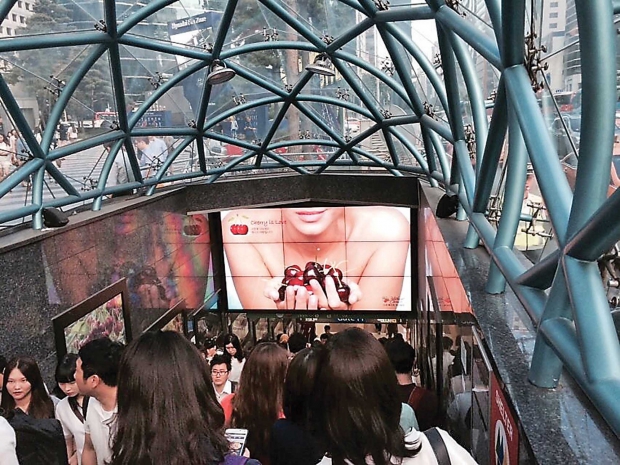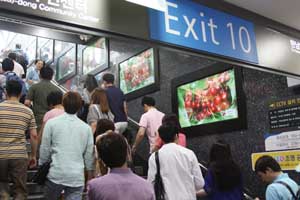
Video and images of Northwest cherries were displayed last summer in the month of July at Gangnam Station in Seoul, South Korea, where more than 400,000 commuters pass daily. (Northwest Cherry Growers)
The 2014 season was not only a record year for Northwest cherries, it was one of the best years for Northwest cherry exports, especially to South Korea, which almost doubled imports from 2012.
“Last year was one of our biggest export years ever,” said Keith Hu, foreign marketing director for Northwest Cherry Growers, the promotional arm for cherry producers in Washington, Oregon, Idaho, Utah, and Montana.

Keith Hu
Washington State produced 23.2 million 20-pound boxes, its largest crop on record, which made export markets an important factor in moving the crop at profitable returns. About a third of the crop, or 7.5 million boxes, were exported to about 40 countries.
Several factors helped Northwest cherry exports, said Hu. “We had a good quality crop and good prices, which helped make our fruit affordable in foreign markets. And, because of the short California cherry crop, importers had pent-up demand. There was high anticipation for our cherries, and retailers were very aggressive in marketing cherries.”
Related story: “China’s cold chain is improving.”
But even with a strong export year, the 1.1 million boxes exported to the Republic of Korea took the Northwest cherry industry by surprise. In 2013, a crop year marred by untimely rains, Northwest cherry producers exported only 490,000 boxes to Korea. In 2012, the first year that import duties were eliminated as part of a free-trade agreement between the United States and Republic of Korea, Northwest cherry producers shipped around 650,000 boxes. Before that, exports to Korea ranged from 250,000 to 350,000 boxes.
“I was anticipating around 800,000 boxes last year, so the 1.1 million boxes was a big surprise,” said Hu.

Video and images of Northwest cherries were displayed last summer in the month of July at Gangnam Station in Seoul, South Korea, where more than 400,000 commuters pass daily. (Northwest Cherry Growers)
Canada has been the top importer of Northwest cherries for more than a decade, taking about 2.5 million boxes last year. China has held the number two spot for the last three years, importing 1.2 million boxes in 2014, which was only about 150,000 boxes more than Korea.
Some of the credit for the strong market for Northwest cherries in Korea goes to Kristie Park. She has been the Northwest Cherry Growers’ representative in Seoul, South Korea, since 2005 when Northwest Cherry Growers opened its first office there. Park also represents several other state agencies and the U.S. High Bush Blueberry Council.
Initially, Park worked to educate importers and retailers about Northwest cherries, focusing on how to handle fruit, the importance of the cold chain, and what makes Northwest cherries unique. In South Korea, about 20 fruit importers handle cherries. Retail cherry sales are concentrated primarily in three major superstore chains and three high-end department store companies, but there are thousands of small grocery stores.
“Korea has only 50 million people compared to China’s 1.1 billion,” Park told Good Fruit Grower. She was in Washington State in December for a training session with all the foreign marketing representatives of Northwest Cherry Growers. “The per capita consumption of cherries in Korea is very high.”
Koreans love cherries, she said, adding that there is no domestic cherry production and only a small volume of California cherries are imported in April and May. “The price of California cherries is always very high,” said Park.
Sales of cherries have dramatically increased since the import duty was eliminated. In 2006, cherry sales (including California) in Korea totaled $11 million, according to Park. Cherry sales were $81 million in 2012, the first year of duty elimination, and $123 million last year.
Park has used marketing techniques that are innovative, unconventional, and low-cost to get the attention of Koreans.
One of the more successful promotions has been what she calls a “cherry pop-up store.” During cherry season, she rents a café-like store for two weeks and decorates it with Northwest Cherry Growers’ banners and posters. The store serves as a hub for distributing informational leaflets, passing out cherry samples, and using social media to draw in young people for photo opportunities and contests.
She also played South Korean musician Psy’s “Gangnam Style” with video and images of Northwest cherries on a large screen for the month of July in downtown Seoul at Gangnam Station, a metro transportation center where 400,000 commuters pass daily.
Another tactic was a 10-member street team that handed out Northwest cherries samples at Haewoondae Beach near Busan. The street team operated under the backdrop of a large banner that told beach visitors where to buy Northwest cherries. More than a million people visit the beach every day during summer.
Park has also covered all four sides of a large truck trailer with Northwest cherry banners to make it look like a big box and parked it in front of retail stores that sell cherries.
Last year, she organized an in-store competition for E-Mart, the largest hyper-market (supercenter) in Korea with 150 stores. The competition helped educate store managers about the value of prominent Northwest cherry displays. One store used impulse buying habits and placed cherries near checkout cashiers. The E-Mart competition increased the chain’s cherry sales by 60 percent, Park noted.
In Korea, Northwest cherries sell for the equivalent of around $10 per pound, according to Park. E-Mart was able to import cherries directly from Northwest shippers, which helped make cherries more affordable for middle class consumers.
Future plans
“It’s getting harder to come up with new strategies to top our previous successes,” said Park. For 2015, she is planning a new “Miss Cherry” contest that will choose a Korean girl to be part of a social media campaign. Park will run contests in which people will try to find Miss Cherry at various locations, with contestants submitting photos taken with Miss Cherry by posting them on Facebook and other social media. Winners will receive small prizes, including Northwest cherries.
Thus far, Northwest cherries have only penetrated Korea’s largest city of Seoul, with its 10 million people and one-fifth of the nation’s population. Hu believes there is great potential for Northwest cherries in second- and third-tier markets, areas that are still untapped.
“Imports could increase another 20 to 30 percent as we reach beyond Seoul and introduce the blush Rainier variety to Korea,” said Hu.
The delicate Rainier variety is harder to ship, but Hu believes it will be very popular with Koreans. “The biggest immediate growth will be from Rainiers,” he predicted. •






Leave A Comment